Related Research Articles
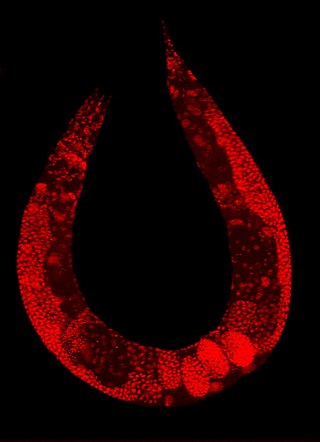
A multicellular organism is an organism that consists of more than one cell, in contrast to unicellular organism. All species of animals, land plants and most fungi are multicellular, as are many algae, whereas a few organisms are partially uni- and partially multicellular, like slime molds and social amoebae such as the genus Dictyostelium.
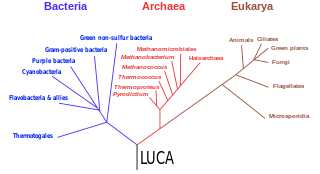
The last universal common ancestor (LUCA) is the most recent population from which all organisms now living on Earth share common descent—the most recent common ancestor of all current life on Earth. This includes all cellular organisms, but not necessarily viruses. The LUCA is not the first life on Earth; it may have lived among a diversity of other organisms whose descendants all died out. Rather LUCA is the most recent form from which all surviving life on Earth is descended.

Amorphea is a taxonomic supergroup that includes the basal Amoebozoa and Obazoa. That latter contains the Opisthokonta, which includes the Fungi, Animals and the Choanomonada, or Choanoflagellates. The taxonomic affinities of the members of this clade were originally described and proposed by Thomas Cavalier-Smith in 2002.

Sterane (cyclopentanoperhydrophenanthrenes) compounds are a class of tetracyclic triterpanes derived from steroids or sterols via diagenetic and catagenetic degradation, such as hydrogenation. Steranes are detected in sediments and sedimentary rocks in nature. Steranes have an androstane skeleton with a side chain at carbon C-17. The sterane structure constitutes the core of all sterols. Steranes are widely used as biomarkers for the presence of eukaryotes in past ecosystems because steroids are nearly exclusively produced by eukaryotes. In particular, cholestanes are diagenetic products of cholesterol in animals, while stigmastanes are diagenetic products of stigmasterols in algae and land plants. However, some bacteria are now known to produce sterols and it is inferred that the ultimate origin of sterol biosynthesis is in bacteria. Sterols are produced via protosterols that are direct cyclization compounds of squalene by the catalysis of oxidosqualene cyclase. All known sterols in eukaryotes are enzymatically extensively modified from protosterols, while organisms that only produce protosterols are not known. The oldest record of modified steranes are in sedimentary rocks deposited ca. 720–820 million years ago. In contrast, diagenetic products of protosterols are widely distributed in older Proterozoic rocks and imply the presence of extinct proto-eukaryotes and/or sterol-producing bacteria before the evolution of crown-group eukaryotes.

Cholestane is a saturated tetracyclic triterpene. This 27-carbon biomarker is produced by diagenesis of cholesterol and is one of the most abundant biomarkers in the rock record. Presence of cholestane, its derivatives and related chemical compounds in environmental samples is commonly interpreted as an indicator of animal life and/or traces of O2, as animals are known for exclusively producing cholesterol, and thus has been used to draw evolutionary relationships between ancient organisms of unknown phylogenetic origin and modern metazoan taxa. Cholesterol is made in low abundance by other organisms (e.g., rhodophytes, land plants), but because these other organisms produce a variety of sterols it cannot be used as a conclusive indicator of any one taxon. It is often found in analysis of organic compounds in petroleum.

A prokaryote is a single-celled organism that lacks a nucleus and other membrane-bound organelles. The word prokaryote comes from the Greek πρό and κάρυον. In the two-empire system arising from the work of Édouard Chatton, prokaryotes were classified within the empire Prokaryota. But in the three-domain system, based upon molecular analysis, prokaryotes are divided into two domains: Bacteria and Archaea. Organisms with nuclei are placed in a third domain, Eukaryota. Prokaryotes evolved before eukaryotes.

An organism is any biological living system that functions as an individual life form. All organisms are composed of cells. The idea of organism is based on the concept of minimal functional unit of life. Three traits have been proposed to play the main role in qualification as an organism:

Holozoa is a group of organisms that includes animals and their closest single-celled (protist) relatives, but excludes fungi and all other organisms. It is a monophyletic group or clade, a lineage consisting of all descendants of a common ancestor. Among these descendants, the protists are of high interest because of their close relationship to animals: in the search for the genes responsible for animal multicellularity within these protists, they help elucidate the nature of the unicellular ancestor of animals.

Diaphoretickes is a major group of eukaryotic organisms, with over 400,000 species. The majority of the earth's biomass that carries out photosynthesis belongs to Diaphoretickes.
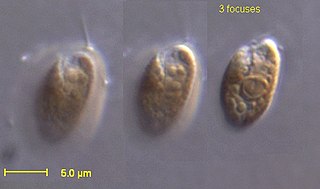
The eukaryotes constitute the domain of Eukaryota, organisms whose cells have a nucleus. All animals, plants, fungi, and many unicellular organisms are eukaryotes. They constitute a major group of life forms, alongside the two groups of prokaryotes, the Bacteria and the Archaea. Eukaryotes represent a small minority of the number of organisms, but due to their generally much larger size, their collective global biomass is about equal to that of prokaryotes.
The Boring Billion, otherwise known as the Mid Proterozoic and Earth's Middle Ages, is the time period between 1.8 and 0.8 billion years ago (Ga) spanning the middle Proterozoic eon, characterized by more or less tectonic stability, climatic stasis, and slow biological evolution. It is bordered by two different oxygenation and glacial events, but the Boring Billion itself had very low oxygen levels and no evidence of glaciation.

Ergostane is a tetracyclic triterpene, also known as 24S-methylcholestane. The compound itself has no known uses; however various functionalized analogues are produced by plants and animals. The most important of these are the heavily derivatised withanolides. However simpler forms do exist, such as the sterane campestane (24R-methylcholestane). Along with cholestane and stigmastane, this sterane is used as a biomarker for early eukaryotes.
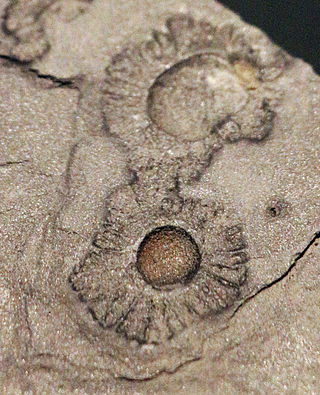
The Francevillian biota are a collection of 2.1-billion-year-old Palaeoproterozoic macroscopic structures, controversially suggested to be fossils, known from the Francevillian B Formation in Gabon, a black shale province notable for its lack of any noticeable metamorphism. The structures have been postulated by some authors to be evidence of the earliest form of multicellular life, and of eukaryotes. They were discovered by an international team led by Moroccan-French geologist Abderrazak El Albani, of the University of Poitiers, France. While they have yet to be assigned to a formal taxonomic position, they have been informally and collectively referred to as the "Gabonionta", including by the Natural History Museum Vienna in 2014. The status of the structures as fossils has been questioned.
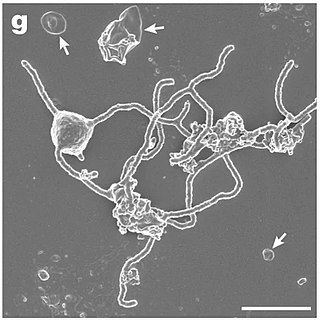
Lokiarchaeota is a proposed phylum of the Archaea. The phylum includes all members of the group previously named Deep Sea Archaeal Group, also known as Marine Benthic Group B. Lokiarchaeota is part of the superphylum Asgard containing the phyla: Lokiarchaeota, Thorarchaeota, Odinarchaeota, Heimdallarchaeota, and Helarchaeota. A phylogenetic analysis disclosed a monophyletic grouping of the Lokiarchaeota with the eukaryotes. The analysis revealed several genes with cell membrane-related functions. The presence of such genes support the hypothesis of an archaeal host for the emergence of the eukaryotes; the eocyte-like scenarios.
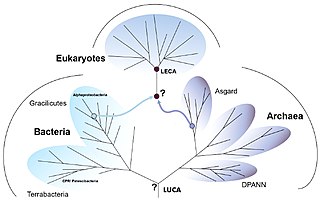
Eukaryogenesis, the process which created the eukaryotic cell and lineage, is a milestone in the evolution of life, since eukaryotes include all complex cells and almost all multicellular organisms. The process is widely agreed to have involved symbiogenesis, in which archaea and bacteria came together to create the first eukaryotic common ancestor (FECA). This cell had a new level of complexity and capability, with a nucleus, at least one centriole and cilium, facultatively aerobic mitochondria, sex, a dormant cyst with a cell wall of chitin and/or cellulose and peroxisomes. It evolved into a population of single-celled organisms that included the last eukaryotic common ancestor (LECA), gaining capabilities along the way, though the sequence of the steps involved has been disputed, and may not have started with symbiogenesis. In turn, the LECA gave rise to the eukaryotes' crown group, containing the ancestors of animals, fungi, plants, and a diverse range of single-celled organisms.
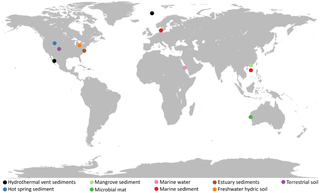
Asgard or Asgardarchaeota is a proposed superphylum consisting of a group of archaea that contain eukaryotic signature proteins. It appears that the eukaryotes, the domain that contains the animals, plants, and fungi, emerged within the Asgard, in a branch containing the Heimdallarchaeota. This supports the two-domain system of classification over the three-domain system.

Stigmastane or 24R-ethylcholestane is a tetracyclic triterpene, along with cholestane and ergostane, this sterane is used as a biomarker for early eukaryotes.
Photoautotrophs are organisms that use light energy and inorganic carbon to produce organic materials. Eukaryotic photoautotrophs absorb energy through the chlorophyll molecules in their chloroplasts while prokaryotic photoautotrophs use chlorophylls and bacteriochlorophylls present in free-floating thylakoids in their cytoplasm. All known photoautotrophs perform photosynthesis. Examples include plants, algae, and cyanobacteria.
A supergroup, in evolutionary biology, is a large group of organisms that share one common ancestor and have important defining characteristics. It is an informal, mostly arbitrary rank in biological taxonomy that is often greater than phylum or kingdom, although some supergroups are also treated as phyla.
References
- ↑ Brocks, Jochen J.; Nettersheim, Benjamin J.; Adam, Pierre; Schaeffer, Philippe; Jarrett, Amber J. M.; Güneli, Nur; Liyanage, Tharika; van Maldegem, Lennart M.; Hallmann, Christian; Hope, Janet M. (June 2023). "Lost world of complex life and the late rise of the eukaryotic crown". Nature. 618 (7966): 767–773. doi:10.1038/s41586-023-06170-w. ISSN 1476-4687.
- ↑ "Australian scientists discover possible "first predators on Earth"-Xinhua". english.news.cn. Retrieved 2023-06-23.
- ↑ ""Protosterol biota" may explain one mysterious gap in the evolution of complex life". Big Think. 2023-06-18. Retrieved 2023-06-23.
- ↑ Brocks, Jochen J.; Nettersheim, Benjamin J.; Adam, Pierre; Schaeffer, Philippe; Jarrett, Amber J. M.; Güneli, Nur; Liyanage, Tharika; van Maldegem, Lennart M.; Hallmann, Christian; Hope, Janet M. (June 2023). "Lost world of complex life and the late rise of the eukaryotic crown". Nature. 618 (7966): 767–773. doi:10.1038/s41586-023-06170-w. ISSN 1476-4687.
- ↑ Lazaro, Enrico de (2023-06-08). "Molecular Remains of Ancient Complex Life Found in 1.6-Billion-Year-Old Rocks | Sci.News". Sci.News: Breaking Science News. Retrieved 2023-06-23.
- ↑ Baisas, Laura (2023-06-09). "Newfound single-celled hunters may have been Earth's first-ever predators". Popular Science. Retrieved 2023-06-23.